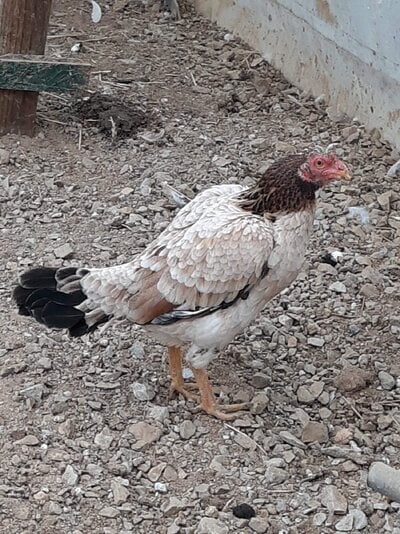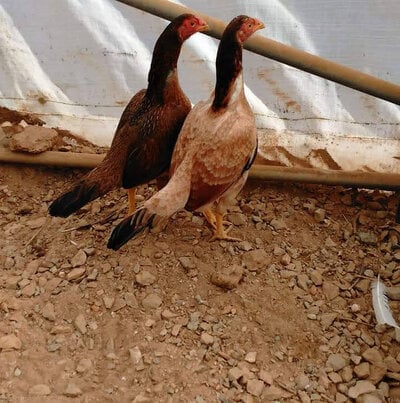Navigation
Install the app
How to install the app on iOS
Follow along with the video below to see how to install our site as a web app on your home screen.
Note: This feature may not be available in some browsers.
More options
You are using an out of date browser. It may not display this or other websites correctly.
You should upgrade or use an alternative browser.
You should upgrade or use an alternative browser.
The aseel thread!!!
- Thread starter fluffycrow
- Start date
He sure is patient posing for the camera. I think he is going to be a real movie star too.

I think there are three: two dark heads on one side, and a light tail on the other side. The tail does not seem to belong to either head.At first I thought there were three with one just being totally squished under everyone else.
Updated pictures of Long.




- Thread starter
- #3
No problem! Getting aseel (mostly, because that's my breed but really ALL Oriental game fowl) the recognition they deserve is something I'm very passionate aboutThanks for doing this, it's very nice of you.
My Primary Goal with my Malays is to Purebreed them, Recreate the PBA with them, & hopefully introduce some different colors into the breed.
Thinking about doing some experimental cross breeding with them, crossing to both my CrackerFowl Hens, & Red JungleFowl.
They're also gonna be used for creating some F1s for my Giant Silkie Project, to help increase their size.
I love you breeding projects, they're so interesting, can't wait for this years pairs and chicks!
I would love to start my breeding project this spring, but I've yet to find a good hen for my rooster, so I don't know if it'll be possible this year
If not, thankfully aseel stay healthy for a long time, and I will fulfil myself with my other chicken projects, if they got to plan that is, and all the other aseel breeding projects of BYC
Red Mangrove
Songster
- Jan 25, 2023
- 629
- 1,562
- 241
My one and only Asil hen just hatched her first clutch of eggs. 21 chicks. She is an absolutely ferocious mother and won't allow other birds within six feet of her babies
She went broody on an old egg dump underneath my house, so she probably has a huge assortment of chicken breeds following her around right now


She went broody on an old egg dump underneath my house, so she probably has a huge assortment of chicken breeds following her around right now
keblow
Chirping
Hey everyone. I just got back on a few days ago after quite a while without internet access, and realized there were also a few replies to me the last time I was in the thread. My apologies if it seemed like I dropped off the face of the earth and ignored responses. I just figured I'd drop a few pics of some of Cackle's Aseels for interest. Too young to judge well yet (3 months) but I can say one hen is actually a decent specimen so far.

This guy seems to have a short body and high tail, no pearl eye, legs too far forward even though the pic angle doesn't reveal it. Not particularly wide or prominently shouldered either. High station, relatively good bone, long neck and pretty good comb are his positives.

I like this girl a lot so far. Nice head and beak shape, wider, prominent shoulders, better leg placement, pearl eye, straight legs and feet. Not quite as big as some of the others, tail not as tight as I like, but a pretty balanced specimen. She might be able to give better type to that stag above.

The other pullet I'm favoring. High station, long neck, long tight tail, straight legs, wings held high. Her head is all right, body a little narrow. I think she might pair well with a solid cock to take advantage of her height and widen the body in the offspring.

This guy is really wide but has a prominent breastbone at the moment. Pearl eye is developing, very peppy fellow (I had him on life support after he took on two other boys and took a beating at 6 weeks - he still is quite aggressive), legs aren't so straight, and his tail is the second worst of the bunch behind the stag up above even though it looks ok here.
The goals I've put together are for the tallest bird I can get out of the genetics I have to work with, medium body size, relatively high stance. Eventually I might blend in some Sumatra on the side for gypsy face and the lacing gene, and at that point I'll be out of this thread and into the Oriental game thread. Actually, I think my original musings may have been there?
These four were the only ones that gave me a good opportunity to picture them, but I have one more hen who shows better type so far. I'm still far from a final assessment for the first year pairings (I'm thinking March). I know breeding to pullets and stags isn't good practice, and after the first year matings i will discontinue it. Also, there will be no culls until 18 months so I don't inadvertently lose a decent bird. Anybody feels like picking these guys apart or sees me making a poor assessment, feel free to comment.
Thanks, and glad to be back on here!
This guy seems to have a short body and high tail, no pearl eye, legs too far forward even though the pic angle doesn't reveal it. Not particularly wide or prominently shouldered either. High station, relatively good bone, long neck and pretty good comb are his positives.
I like this girl a lot so far. Nice head and beak shape, wider, prominent shoulders, better leg placement, pearl eye, straight legs and feet. Not quite as big as some of the others, tail not as tight as I like, but a pretty balanced specimen. She might be able to give better type to that stag above.
The other pullet I'm favoring. High station, long neck, long tight tail, straight legs, wings held high. Her head is all right, body a little narrow. I think she might pair well with a solid cock to take advantage of her height and widen the body in the offspring.
This guy is really wide but has a prominent breastbone at the moment. Pearl eye is developing, very peppy fellow (I had him on life support after he took on two other boys and took a beating at 6 weeks - he still is quite aggressive), legs aren't so straight, and his tail is the second worst of the bunch behind the stag up above even though it looks ok here.
The goals I've put together are for the tallest bird I can get out of the genetics I have to work with, medium body size, relatively high stance. Eventually I might blend in some Sumatra on the side for gypsy face and the lacing gene, and at that point I'll be out of this thread and into the Oriental game thread. Actually, I think my original musings may have been there?
These four were the only ones that gave me a good opportunity to picture them, but I have one more hen who shows better type so far. I'm still far from a final assessment for the first year pairings (I'm thinking March). I know breeding to pullets and stags isn't good practice, and after the first year matings i will discontinue it. Also, there will be no culls until 18 months so I don't inadvertently lose a decent bird. Anybody feels like picking these guys apart or sees me making a poor assessment, feel free to comment.
Thanks, and glad to be back on here!
I don't know which exact genes are making the color difference in the birds you see, but obviously there are some differences. I assume the differences in the Cornish came from the same ancestors that caused the change in body shape.Big question here is what's the difference between them. I know Dark Cornish have game fowl in them. The picks of a lot these roo's are identical (minus some build) to Cornish and it seems that the hens are a game fowl color, instead of the darker double lacing???
Chicken color genes can be confusing.
Sometimes the same genes will make chickens that look different than each other (example: wheaten roosters vs. wheaten hens).
Sometimes different genes will make chickens that look alike (example: wheaten roosters vs. duckwing roosters.)
Sometimes different genes will make chickens that look different (example: wheaten hens vs. duckwing hens, which is part of how we know that wheaten and duckwing are actually caused by different genes.)
So for now I'll just say "genetic differences" account for the color differences.
Many chicken genes have been studied and given names. Some of the other posts were discussing specific genes by name, or by the abbreviations for their names. But if you don't already know the names or abbreviations, it just looks like a bunch of nonsenseI don't understand the genetic talk here or in some of the other post. Not going back to the beginning to quote kanoid???? etc genetics just saying I don't understand before asking my question.

Some people find it useful to learn about the color genetics, and some find it just plain fun, but other people don't need to learn it if they don't find it fun or useful. (I think the people who actually do enjoy genetics are pretty rare
 )
)keblow
Chirping
I'm clear that Aseels have tons of variation. What I'm looking for is the proper body shape, not the entire package. Shear off the legs, neck and tail and look at what's left. If it's got a big fluffy butt and soft, deep abdomen, I think all of us would agree it's not an Aseel at all. How does that bird function if it's got a laying hen's body with some Aseel-like appendages? Same with a flat, skinny body. Where are the lungs, heart and other organs? Crammed up inside and likely less efficient. Maybe breeding purely based on performance eliminates those outliers, but I won't be actually fighting my birds to find out. So where do I go from there? I think gameness can be determined outside the pit, and even conditioned birds surprise their owners sometimes.
Hopefully this isn't considered promoting illegal activity, which I am not intending. If you think it's pushing it I'll delete it. Games are difficult because staying true to their nature necessitates pondering things like this, and I wish people didn't jump to conclusions about those who own them.
Hopefully this isn't considered promoting illegal activity, which I am not intending. If you think it's pushing it I'll delete it. Games are difficult because staying true to their nature necessitates pondering things like this, and I wish people didn't jump to conclusions about those who own them.
New posts New threads Active threads
-
Threads with more replies in the last 15 days
-
Moderator Appreciation 2025
- Started by Nifty-Chicken
- Replies: 100
-
Ended Official BYC Poultry Caption Contest 06-20-25 Pic by Jenbirdee
- Started by TwoCrows
- Replies: 67
-
URGENT hen with potential water belly not eating or drinking
- Started by Belovedturkey
- Replies: 62
-
Investigating Problems Uploading Images to the Gallery & Posts
- Started by casportpony
- Replies: 62
-
-
×






